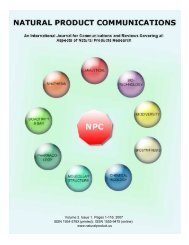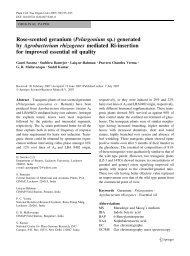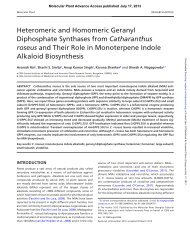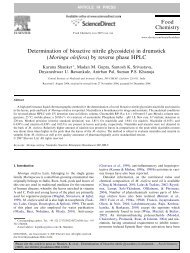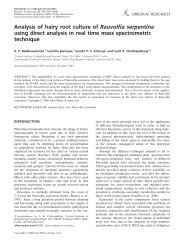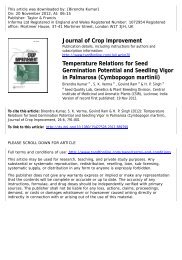Recent advances in plant hepatoprotectives - CIMAP Staff - Central ...
Recent advances in plant hepatoprotectives - CIMAP Staff - Central ...
Recent advances in plant hepatoprotectives - CIMAP Staff - Central ...
Create successful ePaper yourself
Turn your PDF publications into a flip-book with our unique Google optimized e-Paper software.
RECENT ADVANCES IN PLANT HEPATOPROTECTIVES<br />
*<br />
761<br />
D. Mode of Action<br />
The hepatoprotective activity of glycyrrhiz<strong>in</strong> has been attributed to its lipid peroxidation <strong>in</strong>hibitory,<br />
antioxidant, anti<strong>in</strong>flammatory, and immunomodulatory activities. 152 Glycyrrhiz<strong>in</strong> enhances hepatic<br />
glucuronidation and activates P450 phase I detoxification reactions <strong>in</strong> animals. Cl<strong>in</strong>ical trials<br />
conducted on patients with chronic hepatitis showed a decrease <strong>in</strong> the serum transam<strong>in</strong>ase levels thus,<br />
decreas<strong>in</strong>g the chance of develop<strong>in</strong>g hepatocellular carc<strong>in</strong>oma.<br />
E. Toxicity and Side Effects<br />
Consumption of large quantity of glycyrrhiz<strong>in</strong> may cause high blood pressure, salt and water<br />
retention, and low potassium levels, which could lead to cardiac problems. Adm<strong>in</strong>istration of licorice<br />
with diuretics or especially with potassium lower<strong>in</strong>g drugs may through potassium <strong>in</strong>to dangerous<br />
low levels. In some cases, over-consumption also leads to hormonal disbalances. For pregnant<br />
women, it can lead to a risk of preterm labor. LD 50 for glycyrrhiz<strong>in</strong> <strong>in</strong> rats was found at 1.94 g/Kg.<br />
F. Future Prospects<br />
Glycyrrhiz<strong>in</strong> has been found more effective <strong>in</strong> viral hepatitis C. The formulation, stronger<br />
neom<strong>in</strong>ophagen C (SNMC) is available <strong>in</strong> market, but treatment with SNMC has <strong>in</strong>herent side effects<br />
like hypertension, sodium and fluid retention and hypokalemia. 153,154 Hence, a better improved<br />
formulation and synthesis of milder derivatives of glycyrrhiz<strong>in</strong> is much needed today.<br />
8. SOME RECENT LEADS<br />
There have been several reports regard<strong>in</strong>g various other hepatoprotective agents.<br />
A. Cliv-92<br />
Cliv-92 is presently emerg<strong>in</strong>g as a potent hepatoprotective agent 155 isolated from the seeds of Cleome<br />
viscosa L<strong>in</strong>ne (Family: Capparidaceae). Basically, it is a mixture of three structurally similar<br />
coumar<strong>in</strong>olignoids (Fig. 13), Cleomiscos<strong>in</strong>s A (16), B (17), and C (18) 156,157 and of which 17 is<br />
reported to be the most potent one. 153 Cliv-92 was potent aga<strong>in</strong>st carbon tetrachloride and phalloid<strong>in</strong><br />
<strong>in</strong>duced liver damage <strong>in</strong> rats. Its hepatoprotective activity was found to be comparable to<br />
silymar<strong>in</strong>. 158<br />
B. Oleanolic Acid<br />
Oleanolic acid (19, Fig. 14), a triterpenic acid found <strong>in</strong> weed Lantana camara L<strong>in</strong>n. (Family:<br />
Verbenaceae), a native to tropical regions. The <strong>plant</strong> is commonly known as ‘‘Kew bug,’’ ‘‘lantana,’’<br />
HO<br />
H 3 CO<br />
O O<br />
O<br />
CH 2 OH<br />
OCH 3<br />
16<br />
O<br />
H 3 CO<br />
O<br />
HOH 2 C<br />
17<br />
O O<br />
O<br />
OCH 3<br />
OH<br />
H 3 CO<br />
HO<br />
H 3 CO<br />
O O<br />
O<br />
CH 2 OH<br />
OCH 3<br />
18<br />
O<br />
Figure 13. Three ma<strong>in</strong> components of Cliv-92: Cleomiscos<strong>in</strong>s A (16), B (17), and C (18).<br />
Medic<strong>in</strong>al Research Reviews DOI 10.1002/med




